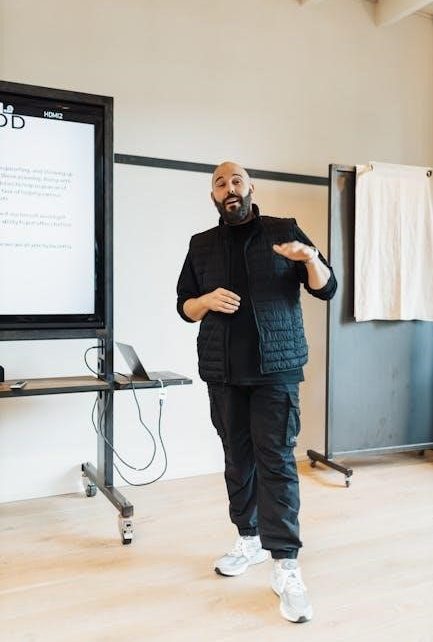Brian Eno, a renowned musician and producer, co-created Oblique Strategies with Peter Schmidt in 1975. These cards offer lateral thinking prompts to overcome creative blocks, inspiring innovation across art and music.
What are Oblique Strategies?
Oblique Strategies are a set of cards created by Brian Eno and Peter Schmidt in 1975. Each card contains a cryptic statement or question designed to spark lateral thinking and overcome creative blocks. These prompts, such as “Honour thy mistake as a hidden intention” or “Only one element in the painting should be coloured,” encourage users to approach problems from unexpected angles. The strategies are not limited to music production but can be applied to various creative fields, including art, design, and writing. They serve as a tool to disrupt routine thinking and foster innovation, making them a timeless resource for anyone seeking fresh perspectives in their work.
Brian Eno’s Contribution to Creative Problem-Solving
Brian Eno revolutionized creative problem-solving through Oblique Strategies, offering a unique approach to overcoming artistic and intellectual challenges. By providing abstract prompts, Eno empowered creators to bypass traditional thinking patterns, fostering innovation. His work bridges music, visual arts, and design, making the strategies versatile and enduring. Eno’s contribution lies in his ability to transform creative blocks into opportunities, ensuring the strategies remain relevant in modern creative processes.

Historical Background of Oblique Strategies
Brian Eno and Peter Schmidt created Oblique Strategies in 1975, pioneering a set of cards with aphorisms to stimulate creativity and solve artistic and intellectual challenges.
The Creation of Oblique Strategies in 1975
In 1975, Brian Eno and Peter Schmidt developed Oblique Strategies as a tool to overcome creative stagnation. Initially, the project began with a series of cards containing cryptic aphorisms designed to provoke new ways of thinking. Eno, a musician and producer, and Schmidt, an artist, aimed to challenge conventional problem-solving methods. The cards were first used during Eno’s recording sessions to spark innovative solutions. This collaboration marked the beginning of a revolutionary approach to creativity, blending art and strategy. The initial deck consisted of over 100 cards, each offering a unique perspective to stimulate lateral thinking. This creation would go on to influence various fields beyond music, including visual arts and design.
The Role of Peter Schmidt in Developing the Concept
Peter Schmidt, a British artist and close collaborator of Brian Eno, played a pivotal role in shaping Oblique Strategies. His artistic perspective complemented Eno’s musical vision, enriching the project’s depth. Schmidt brought a visual and conceptual sensibility, contributing numerous aphorisms that balanced ambiguity with clarity. His input ensured the cards were not only thought-provoking but also visually striking, enhancing their appeal. Schmidt’s collaborative spirit and creative insight were instrumental in transforming the initial idea into a tangible, impactful tool. Together, Eno and Schmidt crafted a unique system that transcended traditional creativity techniques, leaving a lasting legacy in art and innovation.
Evolution of Oblique Strategies Over the Years
Since their creation in 1975, Oblique Strategies have evolved significantly, adapting to the changing creative landscape. Initially designed as a physical deck of cards, the strategies expanded across multiple editions, with new aphorisms added in 1978 and 1979. Over time, the concept transitioned from a niche tool for musicians to a widely recognized method for fostering creativity in various fields. The rise of digital platforms led to unofficial PDF versions, making the strategies more accessible globally. Additionally, the principles behind Oblique Strategies inspired new creative tools and software, ensuring their relevance in modern artistic and design processes. This evolution underscores their enduring influence on innovation and problem-solving.

Structure and Content of Oblique Strategies
Oblique Strategies consists of over 100 cards, each featuring concise, provocative aphorisms designed to stimulate lateral thinking and break creative blocks.
The Physical Deck of Cards: Design and Layout
The Oblique Strategies deck consists of over 100 cards, each featuring a unique aphorism or question printed in a clean, minimalist design. The original cards were handcrafted by Brian Eno and Peter Schmidt, with a simple white background and black text, emphasizing clarity and focus. The deck’s physicality is central to its appeal, offering a tactile experience that encourages users to engage deeply with the strategies. Over the years, the design has remained largely unchanged, preserving its timeless and universal appeal. The cards’ portability and straightforward layout make them accessible for use in various creative settings, from music studios to art workshops.
Examples of Strategies and Their Interpretations
Each card in Oblique Strategies presents a concise and thought-provoking statement, such as “Honour thy mistake as a hidden intention” or “Only one element in the whole thing is different.” These phrases are open to interpretation, allowing users to apply them uniquely to their creative challenges. For instance, “Humanize something free of error” might inspire a musician to introduce intentional imperfections into a track, while an artist could interpret it by adding organic textures to digital work. The strategies encourage indirect approaches to problem-solving, fostering lateral thinking and breaking creative stagnation. Their ambiguity makes them universally applicable across various artistic disciplines, ensuring relevance for diverse projects and mediums. This versatility has cemented their enduring influence in creative workflows.
How the Cards Promote Lateral Thinking

Oblique Strategies foster lateral thinking by presenting ambiguous, open-ended prompts that challenge users to reinterpret problems creatively. For instance, a card might suggest, ” Honour thy mistake as a hidden intention,” encouraging artists to view errors as opportunities rather than setbacks. These statements push creators to think outside conventional frameworks, exploring unconventional solutions. The randomness of drawing a card introduces unexpected perspectives, disrupting stale thought patterns. By shifting focus away from obvious approaches, the cards stimulate innovative connections and ideas. This method is particularly effective in breaking creative blocks, as it redirects attention to fresh possibilities, making it a powerful tool for artists, musicians, and designers seeking new inspiration. The strategies’ indirect nature ensures they remain relevant across diverse creative disciplines, continually sparking original thinking.

The Influence of Oblique Strategies on Music and Art
Oblique Strategies has profoundly impacted music and art by offering unique creative prompts that inspire innovation. Many artists use the cards to break creative blocks and explore new ideas.
Use in Music Production: Breaking Creative Blocks
Oblique Strategies are widely used in music production to overcome creative stagnation. Each card presents a unique prompt, such as “Use an old idea” or “Change nothing and continue with the same,” encouraging artists to think differently. Brian Eno and Peter Schmidt developed these cards to disrupt traditional workflows, fostering innovation. Many renowned musicians, including Aphex Twin, have utilized them to explore new sounds and approaches. The strategies help in reimagining projects, breaking creative blocks, and pushing boundaries. This tool has become essential for producers seeking fresh perspectives, making it a cornerstone in modern music production processes.
Applications in Visual Arts and Design
Oblique Strategies have proven invaluable in visual arts and design, offering unexpected prompts to stimulate creativity. Artists use these cards to challenge conventions and explore new approaches. For instance, prompts like “Humanize something free of error” encourage designers to rethink their processes. The strategies foster lateral thinking, helping to overcome creative stagnation. Many visual artists incorporate these cards into their workflows, finding inspiration in their unpredictable suggestions. This tool has also influenced generative art, where algorithmic processes mimic the card-based approach. By providing fresh perspectives, Oblique Strategies continue to inspire innovation across various mediums, from installations to graphic design, making them a timeless resource for visual creatives.
Impact on Generative Art and Innovation
Oblique Strategies have profoundly influenced generative art and innovation, inspiring artists to embrace unpredictability in their creative processes. By integrating these cards into algorithmic systems, generative artists can create dynamic, adaptive works that evolve beyond traditional frameworks. For example, prompts like “Imagine the music as a moving chain” have inspired the development of generative music tools like Koan Pro and Max/MSP. These strategies encourage artists to challenge conventional methods, fostering groundbreaking outcomes. The principles of Oblique Strategies have also been adapted into software, enabling the creation of interactive installations and live performances. Their influence extends beyond music, shaping the future of generative art and encouraging continuous experimentation in digital and multimedia formats. This legacy underscores their enduring relevance in modern artistic innovation.

Digital Versions and PDF Availability
Digital versions of Brian Eno’s Oblique Strategies are widely available as free PDFs, offering over 150 creative prompts. Official and unofficial editions, including a version by Matthew Davidson, can be downloaded online.
Free PDF Downloads and Online Resources
Free PDF versions of Brian Eno’s Oblique Strategies are readily available online, offering convenient access to over 150 creative prompts. Websites like Monoskop and stretta.com provide downloadable files, ensuring artists and musicians can easily incorporate these strategies into their workflows. The PDFs include the complete set of original cards, designed to inspire lateral thinking and break creative blocks. These resources are widely shared, making Eno’s innovative tool accessible to a global audience. Whether for music production, visual arts, or everyday problem-solving, the PDF format ensures portability and ease of use, aligning with Eno’s vision of democratizing creativity.
Official vs. Unofficial Versions: What’s the Difference?
The official Oblique Strategies deck, created by Brian Eno and Peter Schmidt, is a physical set of cards with unique designs and layouts. Unofficial PDF versions, widely available online, replicate the content but lack the original tactile experience. While these digital copies provide accessible alternatives, they often omit the nuanced design elements of the official cards. Official versions are printed in limited editions, making them collectibles for enthusiasts. Unofficial PDFs, however, serve as practical tools for everyday use, offering the same conceptual framework at no cost. The distinction lies in authenticity, design fidelity, and the sensory interaction that the physical cards provide, which many creators find invaluable for sparking creativity.

Legal and Ethical Considerations of Sharing the PDF
Sharing the Oblique Strategies PDF raises legal and ethical concerns, as the content is protected under copyright by Brian Eno and Peter Schmidt. Distributing or downloading unofficial versions without permission may infringe on these rights. Ethically, it is important to respect the creators’ intellectual property and consider purchasing the official deck to support their work. While unofficial PDFs are widely available, their legality is questionable, and using them may undermine the value of the original creation. Users are encouraged to explore official sources or seek permission before sharing or using the strategies, ensuring fair compensation and acknowledgment of the artists’ contributions to creative problem-solving.

Practical Applications of Oblique Strategies
Oblique Strategies are widely used in music production, visual arts, and design to stimulate creativity and overcome creative blocks. They inspire innovative thinking and problem-solving across various disciplines, fostering brainstorming and collaboration in both artistic and professional contexts, making them a versatile tool for daily creative processes and projects.
Using the Cards in Creative Workflows
Oblique Strategies are a powerful tool for integrating creativity into workflows. By drawing a card, users confront unexpected prompts that challenge conventional thinking. Musicians, artists, and designers often incorporate the cards during brainstorming or when facing creative blocks. The strategies encourage lateral thinking, pushing individuals to explore unconventional approaches. For example, a card might suggest “Only one element in the painting should be familiar” or “Use an old word.” These prompts stimulate innovation and collaboration, making them a versatile addition to various creative processes. Whether in music production, visual arts, or design, the cards foster a mindset of exploration and adaptability, helping to break through creative stalemates and enhance overall workflows. Their flexibility ensures they remain a valuable resource across disciplines.
Case Studies: Famous Artists Who Used Oblique Strategies
Many renowned artists have embraced Oblique Strategies to spark creativity. David Bowie, for instance, frequently used the cards during his collaborative work with Brian Eno, particularly during the recording of albums like Low and Heroes. Similarly, Talking Heads incorporated the strategies to break creative blocks while producing their iconic album Remain in Light. Aphex Twin has also cited the cards as a source of inspiration, using them to explore unconventional sounds and production techniques. These case studies highlight how Oblique Strategies have become a timeless tool for fostering innovation and pushing artistic boundaries across various disciplines, from music to visual arts and beyond.
Integrating the Strategies into Daily Creative Processes
Artists and creators can seamlessly integrate Oblique Strategies into their daily workflows by incorporating the cards as a routine brainstorming tool. Drawing a card at the start of a project or during a creative block can offer fresh perspectives and stimulate unconventional thinking. Many users find success by combining the cards with mind-mapping or free-writing exercises, allowing the prompts to guide their ideas. Additionally, digital versions of the strategies enable easy access on mobile devices, making them a portable and versatile resource. By embracing this method, individuals can transform routine challenges into opportunities for innovation, fostering a mindset of continuous creative exploration and growth. This approach ensures that Oblique Strategies remain a dynamic and practical tool for modern creators.

The Legacy of Oblique Strategies
Oblique Strategies remain a timeless tool for creativity, inspiring artists across disciplines. Their enduring relevance lies in fostering lateral thinking and innovation, making them essential for modern creators.
Why Oblique Strategies Remain Relevant Today
Oblique Strategies continue to inspire creativity and innovation across various fields. Their timeless appeal lies in their ability to challenge conventional thinking and stimulate lateral problem-solving. By offering unexpected perspectives, they help artists, musicians, and designers break through creative blocks. The strategies’ versatility allows them to be applied to diverse challenges, from music production to visual arts. In today’s fast-paced, technology-driven world, the need for fresh ideas and unconventional approaches remains as urgent as ever. Digital versions, including PDFs, have made these strategies more accessible, ensuring their influence extends to new generations of creators. Their enduring relevance underscores the value of intuitive, human-centered approaches in fostering innovation and artistic expression.
Modern Alternatives and Inspired Tools
Modern alternatives to Oblique Strategies include digital apps and online platforms that offer similar creative prompts. These tools provide random exercises and ideas to overcome creative blocks, inspired by Eno’s original concept. Some apps integrate AI to generate tailored suggestions, enhancing the versatility of the strategies. Digital versions ensure accessibility, making Eno’s methods available to a broader audience. These tools preserve the essence of Oblique Strategies while adapting to contemporary creative needs. By leveraging technology, they continue to inspire artists, musicians, and designers, maintaining the relevance of Eno’s innovative approach in fostering creativity and problem-solving across various disciplines.

Brian Eno’s Other Contributions to Creativity and Innovation
Beyond Oblique Strategies, Brian Eno has profoundly influenced creativity and innovation through his work in music, art, and technology. As a pioneer of ambient music, he released groundbreaking albums like Ambient 1: Music for Airports, redefining soundscapes. Eno’s collaborations with artists like David Bowie, Talking Heads, and Coldplay have shaped modern music production. His generative music experiments and use of algorithmic composition have inspired new approaches to sound design. Additionally, Eno’s work in visual arts and installations has expanded the boundaries of multimedia expression. His philosophical writings and lectures on creativity further solidify his role as a visionary thinker, continually pushing the limits of artistic and technological expression.
Brian Eno’s Oblique Strategies remain a timeless tool for overcoming creative challenges, offering inspiration across music, art, and innovation. Exploring the PDF provides a gateway to Eno’s enduring legacy.
Final Thoughts on the Importance of Oblique Strategies
Oblique Strategies by Brian Eno and Peter Schmidt are a timeless resource for creatives. These cards, available in PDF, offer unique prompts to stimulate lateral thinking and break creative blocks. Their relevance spans decades, influencing music, art, and innovation. By encouraging unconventional approaches, they inspire fresh perspectives and problem-solving, making them an invaluable tool for anyone seeking to enhance their creative processes. The PDF format ensures accessibility, allowing artists and thinkers worldwide to benefit from Eno’s visionary approach, fostering endless possibilities for imaginative and innovative work.
Encouragement to Explore and Use the Cards
Exploring Oblique Strategies is a rewarding journey for any creative mind. Whether you’re a musician, artist, or thinker, these cards offer fresh perspectives to overcome challenges. The availability of a free PDF ensures accessibility, allowing you to easily integrate this tool into your workflow. By embracing the unpredictability of the cards, you can unlock new ideas and approaches that might otherwise remain unexplored. Eno’s strategies are not just for music; they apply to any creative endeavor, fostering innovation and lateral thinking. Dive into the world of Oblique Strategies and discover how they can inspire your next project or spark a breakthrough in your creative process.



